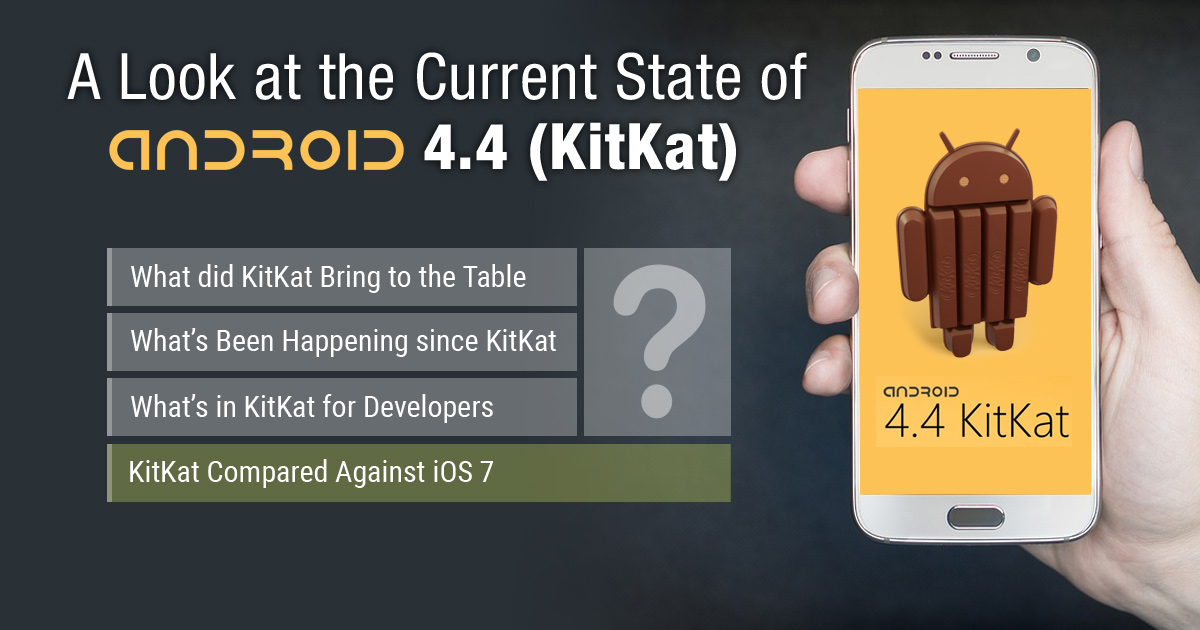Posted By
Gaurang Patel
on
22. April 2014 05:55
With Android 4.4 debuting on the Nexus 5 back in October, developers and users have had some time to get used to the new operating system. Originally, released on October 13 on Nexus 5 and then extending to other devices, the KitKat upgrade boasted an impressive list of new features designed to enhance the usability of the OS as well as make it even easier to develop for.
.jpg)
What did KitKat Bring to the Table?
Among the original features of KitKat is ‘OK Google’ – a replacement of ‘Google Now’ that enhances voice commands. An updated ‘Hangout’ application allows users to store almost every online communication in one place. KitKat was enhanced with a predictive search-based input that uses data from a user’s most dialed and typed locations. An exciting Caller-ID feature on the Nexus 5 can identify inbound and outbound numbers even if they are not saved as contacts. ‘Immersive Mode’ hides Android’s on-screen notifications and buttons to give apps more canvas space. Cloud printing and cloud storage enables users to use these options from their mobile devices. Additionally, KitKat has some under-the-hood improvements to memory management and security.
What’s Been Happening since KitKat?
KitKat has undergone three critical updates since debuting. The 4.4.1 update added an update to the camera, some minor keyboard changes, and bug and UI fixes. The 4.4.2 update added a full screen mode, wireless printing, improved battery life, and the option to revert to default settings. Finally, the latest update, 4.4.3, fixed unstable data connections and further enhanced the battery life and the camera focus.
What’s in KitKat for Developers?
KitKat added support for simple screen recording. The screen recording utility allows developers to start and stop recording on a device that’s connected to the Android SDK environment over a USB. This is helpful not only with recording high quality video to show off your app, but also to find bugs and test various features. Also assisting with debugging is the Procstats debugging tool that makes it easier for developers to assess their memory usage. It’s especially useful if your app launches background services because you can see how much memory they are using.
The Google Cloud Print App allows for smooth integration between apps and printing processes. Access of sms/mms is also made simpler with KitKat. Developers can also take advantage of animated transitions, a translucent system UI, and improved storage access that facilitates in requesting and sending content to the provider.
KitKat Compared Against iOS 7
KitKat’s main competition is Apple’s iOS 7 which launched in September, shortly before Android 4.4. The striking new interface of iOS 7 looks far better than its previous version and includes the ‘Control Center’ feature to efficiently toggle on and off certain settings. KitKat looks similar to its previous version with only slight changes like a transparent status bar and easy switching between the home screen and notifications.
When comparing crash ratios, KitKat is slightly in the lead. Compared to its previous versions, iOS 7 crashes 1.7% of the time, while KitKat crashes only at a 0.7% rate compared to its previous versions.
However, the largest difference that everyone is aware of is the acceptance rate of the operating systems. iOS 7 still takes a whopping 85% of the market while KitKat lags way behind with only 8%.
Yet, 8% of all mobile users is still a large number of users and the adoption rate of Android is gaining. Overall Android’s KitKat 4.4 OS has positive reviews. According to user reviews on Engadget, KitKat has a 9.2 out of 10 while critics are giving it an average of 8.6. It may be time to consider Android as a serious contender in the mobile space.
Rate This Post:
d71a9f72-1da0-4aa1-9bd6-9ceb52139dfe|4|4.8



